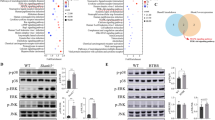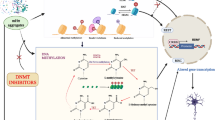Abstract
Purpose
Ghrelin, a gastric hormone, provides a hunger signal to the central nervous system to stimulate food intake. Ghrelin also modulates neuroinflammatory and apoptotic processes. Dedicator of cytokinesis 4 (DOCK4), a guanine nucleotide exchange factor (GEF), is involved in the regulation of neuronal polarization and axon regeneration. However, the effect of DOCK4 on ghrelin production has not been explored.
Methods
The expression of DOCK4 in human and mouse stomach was examined by immunohistochemical staining. The synthesis and secretion of ghrelin in Dock4 null mice were evaluated by real-time quantitative PCR, Western blot and ELISA. The effects of DOCK4 on ghrelin production in mHypoE-42 cells were measured by real-time quantitative PCR and Western blot.
Results
We showed that DOCK4 was expressed in both human and mouse gastric ghrelin cells. The mRNA and protein levels of gastric ghrelin, as well as ghrelin secretion, were remarkably diminished in Dock4 null mice. Furthermore, we showed that overexpression of Dock4 significantly stimulated ghrelin expression, while siRNA knockdown of endogenous Dock4 resulted in a marked decrease of ghrelin in mHypoE-N42 cells.
Conclusions
Our results identify DOCK4 as a critical regulator for ghrelin production in gastric X/A-like cells.




Similar content being viewed by others
Data availability
All data relevant to the study are included in the article or uploaded as supplemental information.
Code availability
Not applicable.
Abbreviations
- GHSR:
-
Growth hormone secretagogue receptor
- DOCK4:
-
Dedicator of cytokinesis 4
- GEFs:
-
Guanine nucleotide exchange factors
- ASD:
-
Autism spectrum disorder
- AD:
-
Alzheimer’s disease
- mHypoE-42:
-
Embryonic mouse hypothalamic cell line N42
- RT:
-
Reverse transcription
References
Mani BK, Shankar K, Zigman JM (2019) Ghrelin’s relationship to blood glucose. Endocrinology 160(5):1247–1261. https://doi.org/10.1210/en.2019-00074
Kojima M, Hosoda H, Date Y, Nakazato M, Matsuo H, Kangawa K (1999) Ghrelin is a growth-hormone-releasing acylated peptide from stomach. Nature 402(6762):656–660. https://doi.org/10.1038/45230
Kageyama H, Funahashi H, Hirayama M, Takenoya F, Kita T, Kato S et al (2005) Morphological analysis of ghrelin and its receptor distribution in the rat pancreas. Regul Pept 126(1–2):67–71. https://doi.org/10.1016/j.regpep.2004.08.031
Müller TD, Nogueiras R, Andermann ML, Andrews ZB, Anker SD, Argente J et al (2015) Ghrelin. Mol Metab 4(6):437–460. https://doi.org/10.1016/j.molmet.2015.03.00
Shi L, Du X, Jiang H, Xie J (2017) Ghrelin and neurodegenerative disorders-a review. Mol Neurobiol 54(2):1144–1155. https://doi.org/10.1007/s12035-016-9729-1
Morgan AH, Rees DJ, Andrews ZB, Davies JS (2018) Ghrelin mediated neuroprotection—a possible therapy for Parkinson’s disease? Neuropharmacology 136(Pt B):317–326. https://doi.org/10.1016/j.neuropharm.2017.12.027
Jeon SG, Hong SB, Nam Y, Tae J, Yoo A, Song EJ, Kim KI et al (2019) Ghrelin in Alzheimer’s disease: pathologic roles and therapeutic implications. Ageing Res Rev 55:100945. https://doi.org/10.1016/j.arr.2019.100945
Rudenko O, Springer C, Skov LJ, Madsen AN, Hasholt L, Nørremølle A et al (2019) Ghrelin-mediated improvements in the metabolic phenotype in the R6/2 mouse model of Huntington’s disease. J Neuroendocrinol 31(7):e12699. https://doi.org/10.1111/jne.12699
Al-Zaid FS, Alhader AA, Al-Ayadhi LY (2014) Altered ghrelin levels in boys with autism: a novel finding associated with hormonal dysregulation. Sci Rep 4:6478. https://doi.org/10.1038/srep06478
Kunimura K, Uruno T, Fukui Y (2020) DOCK family proteins: key players in immune surveillance mechanisms. Int Immunol 32(1):5–15. https://doi.org/10.1093/intimm/dxz067
Xiao Y, Peng Y, Wan J, Tang G, Chen Y, Tang J et al (2013) The atypical guanine nucleotide exchange factor Dock4 regulates neurite differentiation through modulation of Rac1 GTPase and actin dynamics. J Biol Chem 288(27):20034–20045. https://doi.org/10.1074/jbc.M113.458612
Makihara S, Morin S, Ferent J, Côté JF et al (2018) Polarized dock activity drives Shh-mediated axon guidance. Dev Cell 46(4):410-425.e7. https://doi.org/10.1016/j.devcel.2018.07.007
Benson CE, Southgate L (2021) The DOCK protein family in vascular development and disease. Angiogenesis 24(3):417–433. https://doi.org/10.1007/s10456-021-09768-8
Shi L (2013) Dock protein family in brain development and neurological disease. Commun Integr Biol 6(6):e26839. https://doi.org/10.4161/cib.26839
Guo D, Peng Y, Wang L, Sun X, Wang X, Liang C et al (2021) Autism-like social deficit generated by Dock4 deficiency is rescued by restoration of Rac1 activity and NMDA receptor function. Mol Psychiatry 26(5):1505–1519. https://doi.org/10.1038/s41380-019-0472-7
Yang X, Guo D, Li K, Shi L (2021) Altered postnatal developmental patterns of ultrasonic vocalizations in Dock4 knockout mice. Behav Brain Res 406:113232. https://doi.org/10.1016/j.bbr.2021.113232
Aran A, Cassuto H, Lubotzky A, Wattad N, Hazan E (2019) Brief report: cannabidiol-rich cannabis in children with autism spectrum disorder and severe behavioral problems-a retrospective feasibility study. J Autism Dev Disord 49(3):1284–1288. https://doi.org/10.1007/s10803-018-3808-2
Cummings DE, Foster-Schubert KE, Overduin J (2005) Ghrelin and energy balance: focus on current controversies. Curr Drug Targets 6(2):153–169. https://doi.org/10.2174/1389450053174569
Locatelli V, Bresciani E, Bulgarelli I, Rapetti D, Torsello A, Rindi G et al (2005) Ghrelin in gastroenteric pathophysiology. J Endocrinol Invest 28(9):843–848. https://doi.org/10.1007/BF03347579
Bremner JD, Moazzami K, Wittbrodt MT, Nye JA, Lima BB, Gillespie CF et al (2020) Diet, stress and mental health. Nutrients 12(8):2428. Doi: https://doi.org/10.3390/nu12082428
Yanagi S, Sato T, Kangawa K, Nakazato M (2018) The homeostatic force of ghrelin. Cell Metab 27(4):786–804. https://doi.org/10.1016/j.cmet.2018.02.008
Peixoto da Silva S, Santos JMO, Silva CE (2020) Cancer cachexia and its pathophysiology: links with sarcopenia, anorexia and asthenia. J Cachexia Sarcopenia Muscle 11(3):619–635. https://doi.org/10.1002/jcsm.12528
Wang W, Andersson M, Iresjö BM, Lönnroth C, Lundholm K (2006) Effects of ghrelin on anorexia in tumor-bearing mice with eicosanoid-related cachexia. Int J Oncol 28(6):1393–400. https://doi.org/10.3892/ijo.28.6.1393
Esteban-Figuerola P, Canals J, Fernández-Cao JC, Arija-Val V (2019) Differences in food consumption and nutritional intake between children with autism spectrum disorders and typically developing children: A meta-analysis. Autism 23(5):1079–1095. https://doi.org/10.1177/1362361318794179
Yamashita Y, Makinodan M, Toritsuka M, Yamauchi T, Ikawa D, Kimoto S et al (2019) Anti-inflammatory effect of ghrelin in lymphoblastoid cell lines from children with autism spectrum disorder. Front Psych 10:152. https://doi.org/10.3389/fpsyt.2019.00152
Geier DA, Geier MR (2007) A prospective assessment of androgen levels in patients with autistic spectrum disorders: biochemical underpinnings and suggested therapies. Neuro Endocrinol Lett 28(5):565–573
Singh K, Zimmerman AW (2015) Sleep in autism spectrum disorder and attention deficit hyperactivity disorder. Semin Pediatr Neurol 22(2):113–125. https://doi.org/10.1016/j.spen.2015.03.006
Abizaid A, Liu ZW, Andrews ZB, Shanabrough M, Borok E, Elsworth JD et al (2006) Ghrelin modulates the activity and synaptic input organization of midbrain dopamine neurons while promoting appetite. J Clin Investig 116(12):3229–3239. https://doi.org/10.1172/JCI29867
Schéle E, Pfabigan DM, Simrén J, Sailer U, Dickson SL (2020) Ghrelin induces place preference for social interaction in the larger peer of a male rat pair. Neuroscience 447:148–154. https://doi.org/10.1016/j.neuroscience.2020.01.027
Hsu TM, Noble EE, Reiner DJ, Liu CM, Suarez AN, Konanur VR et al (2018) Hippocampus ghrelin receptor signaling promotes socially-mediated learned food preference. Neuropharmacology 131:487–496. https://doi.org/10.1016/j.neuropharm.2017.11.039
Park SB, King S, MacDonald D, Wilson A, MacKay H, Woodside B et al (2021) Contribution of growth hormone secretagogue receptor (GHSR) signaling in the ventral tegmental area (VTA) to the regulation of social motivation in male mice. Transl Psychiatry 11(1):230. https://doi.org/10.1038/s41398-021-01350-6
Huang HJ, Chen XR, Han QQ, Wang J, Pilot A, Yu R et al (2019) The protective effects of Ghrelin/GHSR on hippocampal neurogenesis in CUMS mice. Neuropharmacology 155:31–43. https://doi.org/10.1016/j.neuropharm
Diano S, Farr SA, Benoit SC, McNay EC, da Silva I, Horvath B et al (2006) Ghrelin controls hippocampal spine synapse density and memory performance. Nat Neurosci 9(3):381–388. https://doi.org/10.1038/nn1656
McNay EC (2007) Insulin and ghrelin: peripheral hormones modulating memory and hippocampal function. Curr Opin Pharmacol 7(6):628–632. https://doi.org/10.1016/j.coph.2007.10.009
Lee J, Lim E, Kim Y, Li E, Park S (2010) Ghrelin attenuates kainic acid-induced neuronal cell death in the mouse hippocampus. J Endocrinol 205(3):263–270. https://doi.org/10.1677/JOE-10-0040
Moon M, Choi JG, Nam DW, Hong HS, Choi YJ, Oh MS et al (2011) Ghrelin ameliorates cognitive dysfunction and neurodegeneration in intrahippocampal amyloid-β1-42 oligomer-injected mice. J Alzheimer’s Dis 23(1):147–159. https://doi.org/10.3233/JAD-2010-101263
Eslami M, Sadeghi B, Goshadrou F (2018) Chronic ghrelin administration restores hippocampal long-term potentiation and ameliorates memory impairment in rat model of Alzheimer’s disease. Hippocampus 28(10):724–734. https://doi.org/10.1002/hipo.23002
Andrews ZB, Erion D, Beiler R, Liu ZW, Abizaid A, Zigman J et al (2009) Ghrelin promotes and protects nigrostriatal dopamine function via a UCP2-dependent mitochondrial mechanism. J Neurosci 29(45):14057–14065. https://doi.org/10.1523/JNEUROSCI.3890-09.2009
Bayliss JA, Lemus MB, Stark R, Santos VV, Thompson A, Rees DJ et al (2016) Ghrelin-AMPK Signaling Mediates the Neuroprotective Effects of Calorie Restriction in Parkinson’s Disease. J Neurosci 36(10):3049–3063. https://doi.org/10.1523/JNEUROSCI.4373-15.2016
Ma LY, Zhang DM, Tang Y, Lu Y, Zhang Y, Gao Y et al (2011) Ghrelin-attenuated cognitive dysfunction in streptozotocin-induced diabetic rats. Alzheimer Dis Assoc Disord 25(4):352–363. https://doi.org/10.1097/WAD.0b013e31820ce536
Miao Y, Xia Q, Hou Z, Zheng Y, Pan H, Zhu S (2007) Ghrelin protects cortical neuron against focal ischemia/reperfusion in rats. Biochem Biophys Res Commun 359(3):795–800. https://doi.org/10.1016/j.bbrc.2007.05.192
Funding
This work was supported by grants from the National Natural Science Foundation of China (82170818, 81770794), the Key-Area Research and Development Program of Guangdong Province (2019B030335001), the Fundamental Research Funds for the Central Universities (21620423).
Author information
Authors and Affiliations
Contributions
Geyang Xu and Lei Shi designed research; Yanling Huang, Yaorong Yang, Daji Guo, Yawen Zhao and Linxi Chen performed research; Geyang Xu and Lei Shi analyzed data; Yanling Huang and Yaorong Yang wrote and edited the paper. All authors contributed to the discussion and revised the article and all approved the final versions of the manuscript. Geyang Xu is responsible for the integrity of the work as a whole.
Corresponding authors
Ethics declarations
Conflicts of interest
On behalf of all authors, the corresponding author states that there is no conflict of interest.
Consent to participate
Informed consent was obtained from all individual participants included in the study.
Consent to publish
The authors affirm that human research participants provided informed consent for publication of the images in Fig. 1.
Ethics approval
Animals used in this study were handled in accordance with the Guide for the Care and Use of Laboratory Animals published by the National Institutes of Health (NIH Publications No. 8023, revised 1978). All animal protocols were approved by the Animal Care and Use Committee of Jinan University. Participation in this study was voluntary and written informed consent was obtained from each participant. The guidelines of the Declaration of Helsinki of the World Medical Association were followed. All protocols were approved by the Research Ethics Committee of the First Affiliated Hospital of Jinan University.
Additional information
Publisher's Note
Springer Nature remains neutral with regard to jurisdictional claims in published maps and institutional affiliations.
Rights and permissions
About this article
Cite this article
Huang, Y., Yang, Y., Zhao, Y. et al. DOCK4 regulates ghrelin production in gastric X/A-like cells. J Endocrinol Invest 45, 1447–1454 (2022). https://doi.org/10.1007/s40618-022-01785-8
Received:
Accepted:
Published:
Issue Date:
DOI: https://doi.org/10.1007/s40618-022-01785-8




